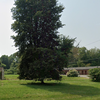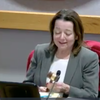Administrators say
Mapping curriculum builds community
GUILDERLAND The Guilderland School District is a local leader in curriculum mapping, based on the work of Heidi Hayes Jacobs, an associate professor at Columbia University's Teachers College.
"We began curriculum mapping almost 10 years ago," Assistant Superintendent for Instruction Nancy Andress told an enthusiastic school board during a presentation last Tuesday.
It was 10 years ago, in 1997, that Jacobss first book on curriculum mapping was published, stressing how mapping could be used to encourage collaboration among teachers, integration of curriculum, and development of more meaningful evaluation.
"For me, much of professional development and curriculum work is really the same," said Andress. "We have developed curriculum but, at the same time, we have built community."
Andress said it costs $60 per teacher per year.
Farnsworth Middle School is at the epicenter of the process. "We realized in a panic we had spotty documentation of social studies at the elementary level," said Andress, and so a shared consensus map was created.
Now, the process is being launched at the high-school level as well.
Curriculum mapping is a calendar-based procedure for creating a database of the operational and planned curriculum a school or district uses. It limits repetition such as different grades teaching the same thing and identifies gaps and areas in need of revision.
"This is much different than the moldy old binders that sit on shelves," said Andress, describing the maps as "living, breathing" documents.
The process capitalizes on what is sound, innovative, and creative in current classroom practices, she said, and it fosters dynamic professional discourse and ongoing collaboration among faculty.
The mapping acts as a blueprint that teachers in any of the district's schools can access and it focuses on "essential learning," she said, with a common vision for desired outcomes regardless of who is teaching or in what school.
The process is constant, said Andress. "You're never really done."
School-board member Gloria Towle-Hilt, who retired in June from teaching at the middle school, said that collaboration was an important part of the process. Classroom teaching can be isolating, said Towle-Hilt. "This breaks those walls down."
"Grand initiative"
Two middle-school supervisors Damien Singleton for math and science and Lynne Wells for English and social studies received extensive training four years ago on curriculum mapping and have conducted workshops since.
Singleton went over a pyramid representation of curriculum with student learning at the top. Curriculum mapping, he said, is primarily focused on the connection between the taught curriculum and student learning but is informed by all levels of curriculum.
Singleton called Guilderland's approach "a very grand initiative" and said, "Our work had to be a collaborative project." It involves everyone who works with the students, he said.
Wells went over the process of mapping, which focuses on content, assessment, skills, essential questions, and the state-set learning standards.
Teachers, she said, mapped themselves. "To know the process, you have to live the process," said Wells. "It's not what you say you're doing; it's what you're actually doing."
She also said, "Our commitment is to bring students to where they can reach."
The "essential questions," she said, "really set the stage for everything." Teachers develop two to five questions for each unit. "At the middle school," said Wells, "you often see the essential questions on the board."
"The sheer scope of this project was quite large and a bit daunting," said Singleton. Teachers have different philosophies and priorities.
"We spent an entire year of people coming to the table with how they interpreted the curriculum," Singleton told the school board, calling it a "painful process." Building consensus, he said, is always a challenge.
There were tears and there was head-banging, said Singleton, as teachers worked together. Experts were brought in to help leadership teams that are sustaining the project. Singleton described the process as "a balance between patience and urgency."
Carol Kelly, a new science and math enrichment teacher at the middle school, spoke with great enthusiasm about curriculum mapping.
She said the first step was to collect data, in diaries and journal maps. "It was soul-searching," said Kelly. "We wrote down everything we do."
The next step, the first read through, she termed "a little scary." That was followed by group reviews and then the creation of core maps through consensus, which Kelly called "the fruits of labor and I mean labor."
From there, points for immediate revision and long-term development were identified, and then the cycle continues.
Kelly also went over Rubicon Atlas, the interactive web-based software that teachers use.
"People are calling it a virtual department meeting," said Wells. She said it was "a virtual lesson-plan book, also."
"It's really live and up-close and personal," said Wells.
Kelly illustrated how a teacher would log on, using a password, and then scroll through different grade levels and subjects to, for example, check out an astronomy lesson.
"They can copy it, fix it, change it, adapt it to meet their classroom needs," she said. "It can go back and forth."
Kelly said that, over the summer when teachers weren't available, she could still find out about lesson plans.
"I don't have to get in the car and come up here and try to find somebody," said Kelly, noting that all of the information is available on-line.
Budget priorities
The school board president, Richard Weisz, polled the eight board members on their priorities for 2008-09 budget.
The majority, while wanting to keep the tax rate reasonable, favored continuing the technology initiatives started this year, maintaining small class sizes, and continuing with the teaching of Spanish at the elementary level as introduced this school year.
Three board members spoke of the importance of professional development for staff and three spoke of the importance of music and art.
Hy Dubowsky said art and music are a priority as they "stimulate the way we learn." His other priority is fitness.
Towle-Hilt wants to look at two-tiered busing and said she is interested in hearing what the committee studying full-day kindergarten has to say.
Colleen O'Connell wants to add modified girls' volleyball so girls can start playing the sport in eighth and ninth grade rather than waiting till they play on the junior varsity or varsity team. She also wants to examine the disparity in class sizes. She cited a German class with 13 students and a French class with 30 and said, "To me, that's too much of a disparity."
Denise Eisele is concerned that salaries for teaching assistants and nurses are too low and she wants to look at risk management. After the transportation department informed her that her son, a BOCES student, was in a minor accident, she received no follow-up call, said Eisele, which led her to ask: Is anyone tracking what's happening, or is it done in isolation, by departments"
Superintendent Greogory Aidala responded that the district has a full-time health and safety officer, and Assistant Superintendent for Business Neil Sanders called the district's risk management "fairly comprehensive" as he itemized its different aspects.
Weisz supports high-school curriculum mapping and wants to "revisit" Advanced Placement courses, he said, looking at distance learning. He also wants to build into the technology program "teaching kids how to be safe on the Internet." Weisz said, "It's their Main Street."
The administration will present the board and a citizens' committee with a draft of the budget in February. The board is slated to adopt a final plan on April 8 and the public will vote on the budget on May 20.
Other business
In other business, the school board:
Authorized the district to share information with investment providers receiving contract exchanges under a retirement plan, as required by the Internal Revenue Service;
Accepted the donation of a trumpet from Carol Case;
Unanimously approved tenure for two administrators Assistant Superintendent for Human Resources Susan Tangorre and Altamont Elementary School Principal Peter Brabant. Aidala said Brabant "is well-loved by parents and students at Altamont Elementary School" and he praised Tangorre for her "hard work and dedication." Brabant, in turn, thanked the board, and thanked Aidala "for modeling for me what it means to develop a colleague";
Heard from Andress that the Guilderland girls' lacrosse team placed statewide in the New York State Public High School Athletic Association Scholar-Athlete Team Award Program. Each winning team had a cumulative average of 90 percent; and
Met in executive session to discuss an issue with a teaching assistant, an issue with a student, and an administrative review.


